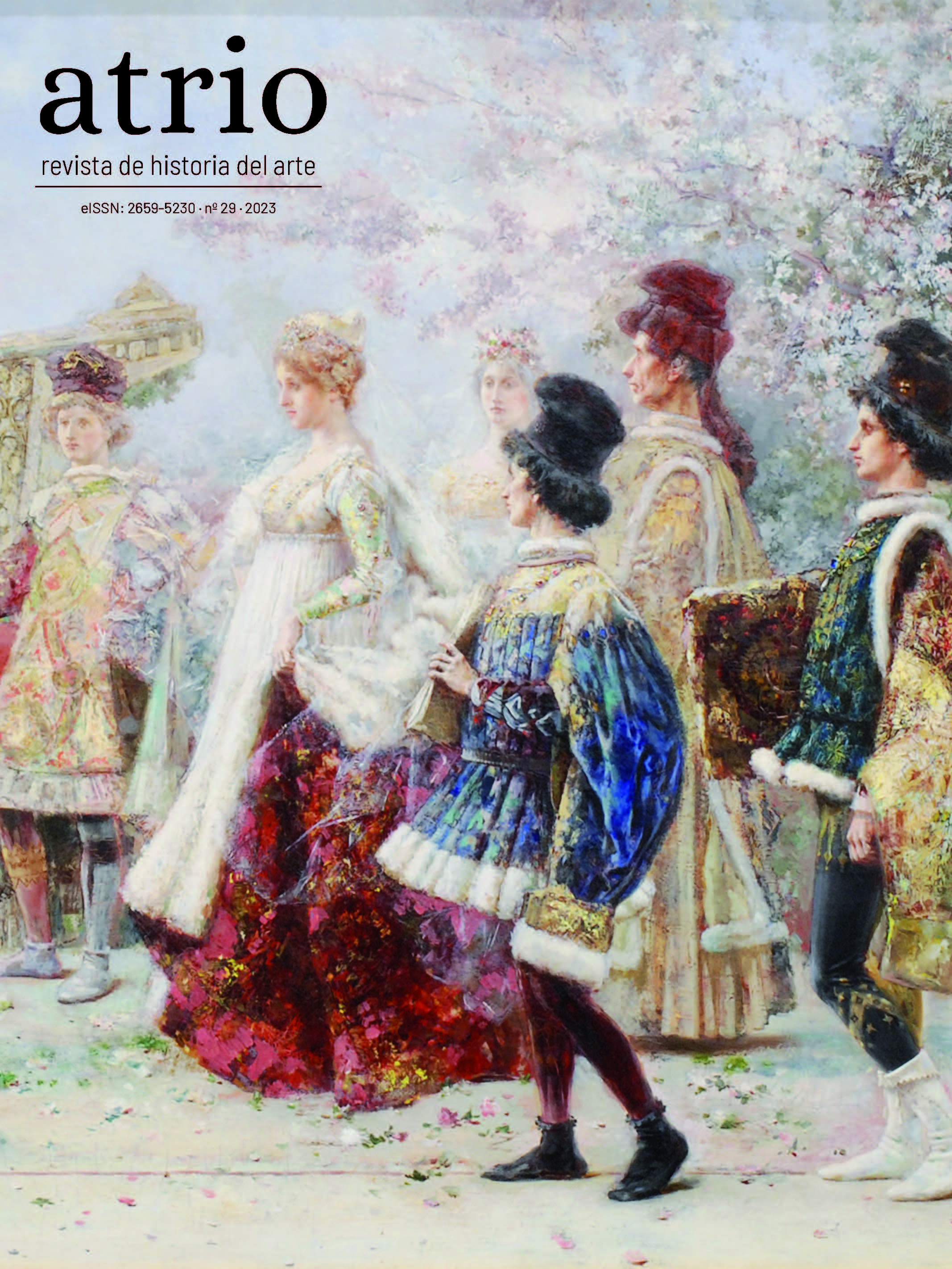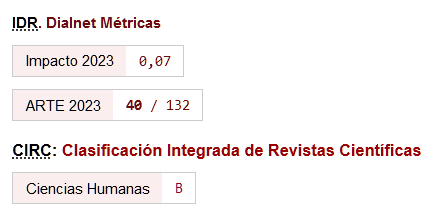Architecture and Death: Spatial Dynamics in the Cemetery of Saldungaray, Province of Buenos Aires, Argentina
Spatial Dynamics in the Cemetery of Saldungaray, Province of Buenos Aires, Argentina.
DOI:
https://doi.org/10.46661/atrio.8129Keywords:
Architecture, Cemetery, Death, Daily use, Ethnography, Spatial dynamicsAbstract
During the 1930s in Argentina (especially in the Province of Buenos Aires) numerous modernization projects were developed by the State. In this context, Francisco Salamone designed and constructed several buildings, including municipalities, cemetery gates, slaughterhouses and squares. The Saldungaray cemetery is one of them, located in the district of Tornquist, which is the focus of this inquiry. This study presents and explores the way in which the historical trajectory establishes distinctive dynamics within the cemetery. These trajectories involve both residents and the municipality, which are embodied in the architecture, tourism, leisure, and the overpopulation of bodies.
Downloads
References
Fuentes documentales:
Decreto 5421/1958, del 23 de abril, del Gobierno de la provincia de Buenos Aires, Interventor Federal de la provincia de Buenos Aires, de 23 de abril de 1958. Consultado el 20 de diciembre de 2022. https://normas.gba.gob.ar/ar-b/decreto/1958/5421/180219.
Ley Provincial N°12854, de 23 de enero, del Gobierno de la Provincia de Buenos Aires, no. 125, de 23 de enero de 2002. Consultado el 25 de febrero de 2023. https://normas.gba.gob.ar/ar-b/ley/2002/12854/4014.
Ordenanza Municipal, 2255/10, de 18 de agosto, del Honorable Concejo Deliberante, Honorable Concejo Deliberante de Tornquist, de 18 de agosto de 2010.
Decreto N°1.138, de 29 de julio, del Poder Ejecutivo Nacional de Monumentos, Lugares y Bienes Histórico, de 29 de julio de 2014. Consultado el 27 de febrero de 2023. https://www.argentina.gob.ar/normativa/nacional/decreto-1138-2014-232796/texto.
Código Tributario Municipal artículo 177°, de 2020, Municipalidad de Tornquist, no. 1. Consultado el 21 de junio de 2022. https://tornquist.gob.ar/ordenanzas-municipales.php.
Código Tributario Municipal artículo 184°, de 2020, Municipalidad de Tornquist, no. 1. Consultado el 21 de junio de 2022. https://tornquist.gob.ar/ordenanzas-municipales.php.
Ley Provincial 12.498 Art. 1º, de 24 de agosto, Gobierno de la provincia de Buenos Aires, Boletín Provincial, de 12 de diciembre de 2000. Consultado el 27 de enero de 2022. https://www.argentina.gob.ar/normativa/provincial/ley-12498-123456789-0abc-defg-894-2100bvorpyel.
Fuentes bibliográficas:
Arffmann, Leif. “Whose cemetery?” Mortality 5, no. 2 (2000): 125-126. https://doi.org/10.1080/713686005.
Bonanno, Flavio. “Activación turística del patrimonio para el desarrollo local: el caso Saldungaray, en el programa pueblos turísticos.” Tesis de maestría, Universidad de Buenos Aires, 2020.
Davies, Douglas, y Alastair Shaw. Reusing old graves. Crayford: Shaw and Sons, 1995.
de Certeau, Michel. The practice of everyday life. Berkeley: University of California Press, 1984.
Dutrénit Bielous, Sílvia. “Los equipos de antropología forense en América Latina. Coadyuvantes en el camino de la verdad y la justicia,” Red Universitaria sobre Derechos Humanos y Democratización para América Latina, no. 3 (2012): 25-53. https://dokumen.tips/documents/02-silvia-dutrenit-bielous-los-equipos-de-antropologia-forense-en-america.html?page=1.
Francis, Doris, Leonie Kellaher, y Georgina Neophytou. “Sustaining cemeteries: The user perspective.” Mortality 5, no. 1 (2000): 34-52. https://doi.org/10.1080/713685994.
Franck, Karen, y Quentin Stevens. Loose Space: Possibility and Diversity in Urban Life. New York: Routledge Taylor & Francis, 2007.
Gehl, Jan. “Public spaces for a changing public life.” En Open Space: People Space, editado por Catharine Ward Thompson y Penny Travlou, 1-8. London: Taylor & Francis, 2007.
Gandulfo, Juan. “El caso de las tumbas NN en Grand Bourg. La justicia y los organismos de Derechos Humanos en la transición a la democracia.” Tesis de maestría, Universidad Nacional de General Sarmiento, 2014.
Grabalov, Pavel, y Helena Nordh. “The Future of Urban Cemeteries as Public Spaces: Insights from Oslo and Copenhagen.” Planning Theory & Practice 23, no. 1 (2022): 81-98. https://doi.org/10.1080/14649357.2021.1993973.
Hall, Edward. The Dance of Life. The other dimension of time. Nueva York: Anchor, 1983.
Korol, Juan Carlos. La economía. 7 vols. Buenos Aires: Sudamericana, 2001.
Kozinets, Rob. Netnography: Doing Ethnographic Research Online. Londres: Sage Publications, 2010.
Martinez, Bárbara. “La muerte como proceso: una perspectiva antropológica.” Ciência & Saúde Coletiva 18 , no. 9 (2013): 2681-2689. http://dx.doi.org/10.1590/S1413-81232013000900023.
Martinez, Bárbara. “Cartografías en tránsito: mapas orales y memoria social en El Cajón (Catamarca, Argentina).” Runa 35, no. 1 (2014): 77-91.
Martinez, Bárbara. “Materialidad, creatividad cultural y práctica social: una etnografía de las cosas del pasado entre los habitantes de San Antonio del Cajón (Catamarca, Argentina).” Corpus 10, no. 2 (2020): 1-23. https://doi.org/10.4000/corpusarchivos.3866.
Meethan, Kevin. “Tourism In Global Society: place, culture, consumption.” Relaciones: Estudios de historia y sociedad 26, no. 103 (2005): 270-277. https://doi.org/10.1016/S0160-7383(01)00097-4.
Miller, Daniel, y Heather Horst. The Digital and the Human: A Prospectus for Digital Anthropology. Londres: Bedford Square, 2012.
Mudimbe, Valentin-Yves. Parables and fables. Madison: University of Wisconsin Press, 1992.
PROTEX (Procuraduría de trata y explotación) y ACCT (Acciones Coordinadas Contra la Trata). Búsqueda de personas en democracia. Actualización de registros, relevamiento de datos, cruces de información e identificaciones de NN. Ciudad de Buenos Aires: Ministerio Publico Fiscal, 2016.
Pérez Leloutre, Santiago. “Marchar al ritmo del tiempo nuevo. Obra pública y edificios municipales de la provincia de Buenos Aires, 1936-1940.” Tesis de maestría, Universidad Torcuato Di Tella, 2018.
Ramos, Jorge. “Salomone en la pampa: una estética del Justísmo”. Ponencia presentada en el Seminario del Instituto de arte latinoamericano e investigaciones estéticas: “Seminario de crítica,” Universidad de Buenos Aires, Ciudad de Buenos Aires, 27 de julio de 2001. http://www.iaa.fadu.uba.ar/publicaciones/critica/0118.pdf.
Rigby, Peter. Cattle, capitalism and class. Ilparakuyo maasai transformations. Philadelphia: Temple University Press, 1992.
Rugg, Julie. “Turismo del Patrimonio funerario: definiciones y principios.” Revista Murciana de Antropología, no. 28 (2021): 31-58. https://doi.org/10.6018/rmu.435441.
Skår, Margrete, Helena Nordh, y Grete Swensen. “Green urban cemeteries: more than just parks.” Journal of Urbanism: International Research on Placemaking and Urban Sustainability 11, no. 3 (2018): 1-22. https://doi.org/10.1080/17549175.2018.1470104.
Sloane, David Charles. The last great necessity: cemeteries in American history. Baltimore: John Hopkins University Press, 1991.
Traversa, Luis Pascual, Ángel Antonio di Maio, Vilma Rosato, y Fabien Iloro. “Arquitectura moderna en la pampa argentina: diagnóstico y restauración de portales de cementerio construidos en la década de 1930.” Apuntes: Revista De Estudios Sobre Patrimonio Cultural 21, no. 2 (2008): 194-205.
Warner, William Lloyd. The living and the dead: a study of the symbolic life of Americans. New Haven: Yale University Press Yankee City, 1959.
Published
How to Cite
Issue
Section
License
Copyright (c) 2023 Silvia Carlini Comerci, Bárbara Martínez

This work is licensed under a Creative Commons Attribution-NonCommercial-ShareAlike 4.0 International License.
Los autores/as que publican en Atrio. Revista de historia del arte están de acuerdo con los siguientes términos:
- Los autores/as conservan los derechos de autor y garantizan a la revista el derecho de ser la primera publicación del trabajo al igual que licenciado bajo una licencia de Creative Commons Attribution-NonCommercial-ShareAlike 4.0 International License que permite a otros compartir el trabajo con un reconocimiento de la autoría de este y la publicación inicial en esta revista.
- El autor/a o cedente del material que se entrega para su publicación autoriza a la revista para que publique, sin obligación alguna (económica o de otra naturaleza), el contenido del referido manual tanto en formato papel, como en digital, así como en cualquier otro medio. Esta cesión de uso del material entregado comprende todos los derechos necesarios para la publicación del material en la revista. Quedan garantizados, simultáneamente, los derechos morales del autor
- El autor/a o cedente es plenamente consciente y está de acuerdo con que todos o cualesquiera de los contenidos proporcionados, formarán una obra cuyo uso se cede a la revista para su publicación total o parcial.
- El autor/a o cedente garantiza ser el titular de los derechos de Propiedad Intelectual sobre los contenidos proporcionados, es decir, sobre el propio texto e imágenes/fotografías/obras fotográficas que se incorporan en su artículo.
- El autor/a o cedente asegura y garantiza: (i) que todo el material enviado a la revista cumple con las disposiciones legales aplicables; (ii) que la utilización de cualquier material protegido por derechos de autor y derechos personales en la concepción del material se encuentra regularizada; (iii) que obtuvo las licencias de derechos, permisos y autorizaciones necesarias para la ejecución del material, inclusive los derechos de imagen, si fueran aplicables; y (iv) que el material no viola derechos de terceros, incluyendo, sin limitarse a estos, los derechos de autor y derechos de las personas.
- El autor/a o cedente, exime a la revista de toda y cualquier responsabilidad con relación a la violación de derechos de autor, comprometiéndose a emplear todos sus esfuerzos para auxiliar a la revista en la defensa de cualquier acusación, medidas extrajudiciales y/o judiciales. Asimismo, asume el abono a la revista de cualquier cantidad o indemnización que esta tenga que abonar a terceros por el incumplimiento de estas obligaciones, ya sea por decisión judicial, arbitral y/o administrativa.













